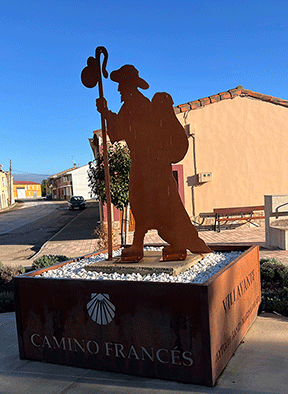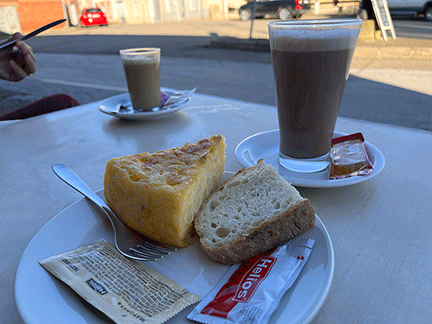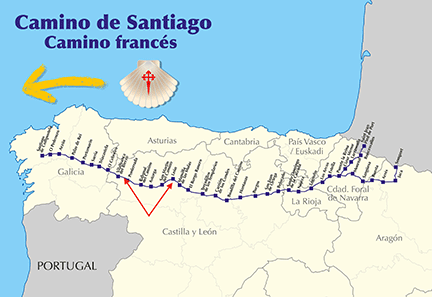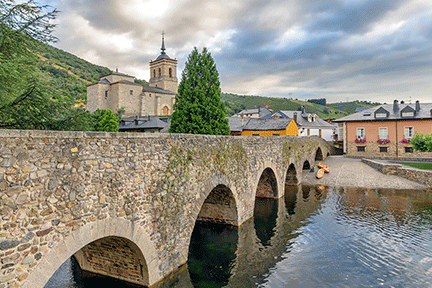Ten Weeks on the Camino: as the final stages draw near, Nick Stark leaves the plains and climbs into the Montes de Leon
Leon to Villa del Mazarife (21 miles)

After an indulgent dive into the gastronomic treats of León we reluctantly hoisted our backpacks and headed west out towards Mazarife and then Astorga. This section marks the end of the Mesesta, the large and mostly featureless plateau that occupies about 135 miles at the Camino’s center. The 21 miles to Mazarife was a mostly bland trudge through the plain’s final dusty margins, and the town itself was notable only for our albergue, Casa Tio Pepé (Uncle Pepé’s House), a traditional bar/restaurant/motel combo presided over by an eponymous avuncular Spaniard. He and his harried assistant checked in a stream of tired pilgrims, served us cañas (small draft beers) and showed us to our rooms with unfailing good humor, and managed to feed us a very respectable seafood paella before we drifted off into the land of nod.
Villa del Mazarife to Astorga (19 miles)
Our destination the next day was Astorga, home to the Episcopal Palace – another Gaudi masterpiece, and something just as important to me – the town is considered the chocolate capital of Spain and even has its own museum devoted to this most important of commodities.

By now September had turned to October and although the sunny but coolish weather was still holding, we had experienced some rainy and windy days, a harbinger of what was to come as we entered Galicia a few days later. The 19-mile walk was punctuated by the charming village of Villavante, where we stopped for the requisite Spanish Elevenses of café con leche and a slice of tortilla espanola, and the picturesque town of Hospital de Orbigo, famed for Romanesque bridge which once spanned a wide and raging river, now sadly reduced through flood control upstream to a feeble little rivulet.
We enjoyed both spots but we didn’t linger. We were eager to get to Astorga and as we entered its Old Town and passed of its countless outdoor bars we spied a couple of faces we recognized from our travels, including Kevin, a gregarious 72-year-old from Derbyshire who greeted me with an ‘hey-up me duck’ as we walked by. This was not our last encounter with this very dear fellow, who became a firm part of our ‘camino family’, as the temporary but firm friendships you make here are known.
Astorga to Foncebaddon (16 miles)
The outskirts of Astorga begin a gradual incline as you head towards the Montes de Leon mountain range. You climb from about 2500ft to a high of about 5,000 as you make your way to the famed Cruz de Ferro. Although the elevation is far lower even than many Southern Californian mountains, plodding uphill in mist and rain with a pack on your back while dodging the ubiquitous horse droppings is far from a walk in the park. By the time you reach Foncebaddon, a hill town which seems exclusively made up of lodgings, you’re ready for a warm drink and a hot meal. We certainly were.
A side note here: Spain doesn’t observe daylight savings time. Back in 1940 when the dictator Francisco Franco wanted to curry favor with the all-conquering Germans, he synchronized Madrid’s time zone to that of Central Europe – specifically Berlin. Where it stays to this day. In practical terms this means the sun rises and sets an hour later than in countries along the same longitude, such as the UK. It certainly suits the locals, who are notoriously late-night creatures, but for us, having our breakfast and setting out for a walk at 8.15am in the pitch dark, it took some getting used to. Especially in Foncebaddon, which was fogged in under rainy skies as we left, headlamps set to high beam!
Foncebaddon to Molinaseca (12 miles)

There are several notable landmarks on the Camino which impart some meaning or other to pilgrims, depending on your depth of belief. The Cruz de Ferro is one of them. Located just outside Foncebaddon, its tall cross atop a mound of stones marks the high point of the journey and is a place to stop and consider the purpose of journey through the Camino – and through life. The guidebooks suggest you bring a pebble from your hometown or some other token of your past life, and leave it here, along with all your regrets, shame and other baggage that no longer serves you. We did just that, but we didn’t linger at the summit. There was one very animated Brazilian lady loudly and tearfully Facetiming a loved one back home, and she was displaying more than enough emotion for us both. So we took a couple of pictures and moved on, happy to anticipate a gentle downhill slope towards the charming town of Molinaseca.

Silly us. One thing we learned from our first day on this trip is that up is much easier than down. Burning quads and glutes are one thing, but aching bones, connective tissue, cartlidge and tendons are another thing entirely. The gentle downhill we had hoped for was instead a rocky, stony, wet, slippery and treacherous three-hour ordeal which we just about negotiated with no contusions or sprains. The reward was Molinaseca, as charming a place as you will find on the Camino, straddling the Meruelo river and boasting yet another gorgeous bridge as you enter. The place has its origins in Spain’s Roman occupation, but today it looks like a graceful and quaint collection of late medieval hotels, inns and taverns. We checked into the Hotel Palacio, our room boasting an unsurpassed view of the bridge and river, and we splurged on a memorable dish of Polbo á feira (Galician-style octopus) at the nearby Casa Ramon restaurant, washed down by a fabulous bottle of the local Godello white wine. It was a good reward for a challenging day.
